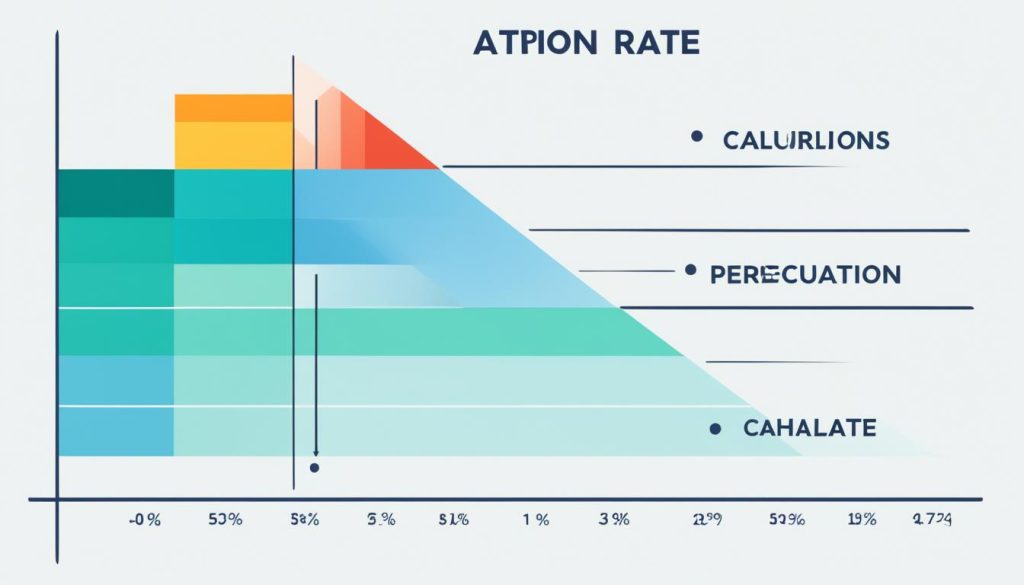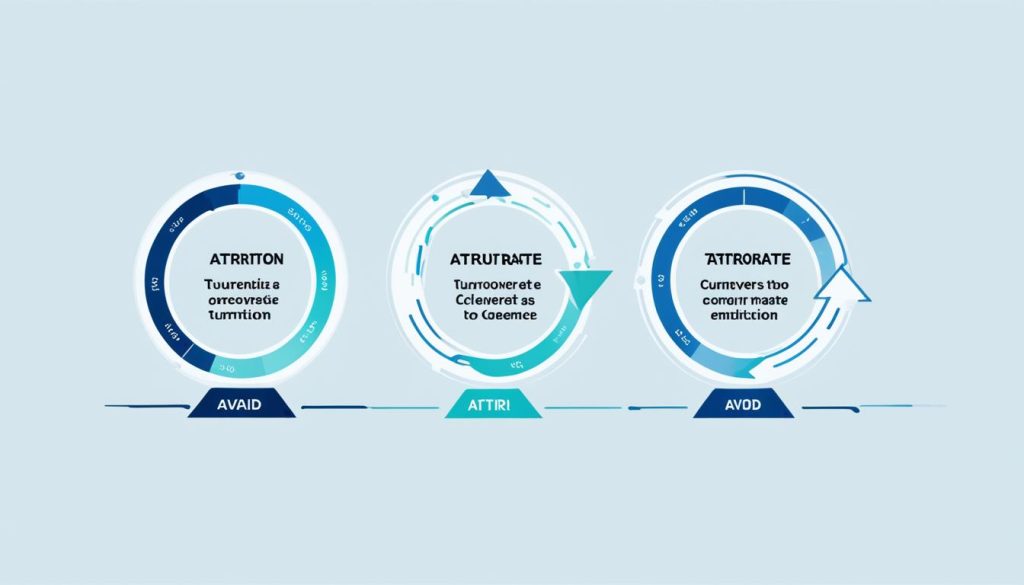Welcome to our simplified guide on how to calculate attrition rate. Understanding and monitoring attrition rate is crucial for HR leaders as it provides insights into employee turnover, allowing them to make informed decisions to improve retention. In this guide, we will explain the attrition rate calculation formula, its definition, and why it is important for your organization’s success.
What is Attrition Rate?
Attrition rate is a crucial metric used by organizations to measure the rate at which employees voluntarily leave their jobs over a specific period. This rate is typically expressed as a percentage and is important for understanding employee turnover within a company. A high attrition rate can indicate underlying issues such as dissatisfaction, poor workplace culture, lack of growth opportunities, or inadequate compensation.
On the other hand, a low attrition rate signifies a stable workforce and a positive work environment. By tracking attrition rate, businesses can assess the effectiveness of their recruitment, retention strategies, and employee engagement initiatives to improve overall employee satisfaction and reduce turnover costs.
Importance of Calculating Attrition Rate
Calculating attrition rate is crucial for HR leaders to understand the health of the organization and the effectiveness of their people strategy. This metric provides valuable insights into the number of people leaving the company and helps identify potential issues. By tracking attrition rate, HR leaders can make informed decisions to improve retention and reduce turnover, ensuring the organization can operate effectively and meet its business objectives.
When it comes to measuring employee attrition rate, it’s essential to have a well-defined calculation method in place. This allows HR leaders to consistently track and analyze attrition trends over time. By accurately calculating the attrition rate, HR departments can gain a clearer understanding of their company’s workforce dynamics and highlight areas for improvement.
Employee attrition rate is a critical metric that HR leaders should pay close attention to. It measures the rate at which employees leave a company voluntarily or involuntarily. High attrition rates can indicate underlying problems within the organization, such as dissatisfaction among employees, poor management practices, inadequate training and development opportunities, or an unhealthy work environment.
By calculating the employee attrition rate, HR leaders can identify patterns and trends, and take proactive measures to address any issues. This includes implementing strategies to improve employee satisfaction, conducting retention-focused initiatives, and reviewing the company’s talent management practices.
A detailed and comprehensive analysis of attrition rate data can provide valuable insights into the overall satisfaction and engagement levels of employees. HR leaders can use this information to pinpoint factors contributing to attrition and develop targeted strategies to reduce turnover. Additionally, tracking attrition rate over time allows HR departments to evaluate the effectiveness of retention programs and make data-driven decisions to enhance employee engagement and retention.
Benefits of Tracking Attrition Rate:
- Identifying potential issues within the organization
- Improving retention and reducing turnover
- Gaining insights into workforce dynamics
- Highlighting areas for improvement
- Enhancing employee satisfaction and engagement
- Optimizing talent management practices

Tracking the attrition rate is a strategic approach that aligns HR practices with organizational goals. It helps HR leaders proactively manage their workforce, retain top talent, and create a positive work environment. By continuously monitoring attrition rate, organizations can adapt and implement strategies that foster employee loyalty and long-term success.
How to Calculate Attrition Rate?
To calculate the attrition rate, you need to follow a simple formula. First, determine the average number of departures in a given period. Then, calculate the average number of employees during that period. Divide the average number of departures by the average number of employees and multiply the result by 100. This will give you the attrition rate as a percentage.
If you’re using data from HR software or a spreadsheet like Excel, you can easily apply this formula. Let’s take an example to illustrate:
Attrition Rate Calculation Example:
In a quarter, an organization had 10 departures and an average of 200 employees. To calculate the attrition rate, divide 10 by 200 and multiply the result by 100. The attrition rate would be 5%.
The attrition rate is a crucial metric for HR leaders to measure the rate at which employees are leaving the company. By calculating the attrition rate, organizations can gain valuable insights into the health of their workforce and identify any potential issues that might be causing high turnover.
What is a Good Attrition Rate?
A good attrition rate is subjective and can vary depending on the industry and company. Generally, an attrition rate of 20% or lower is considered good. However, it is important to compare the attrition rate to similar companies in the industry to get a more accurate benchmark. HR leaders should also take into account the specific circumstances of the organization and strive to improve attrition rate through effective retention strategies.

Attrition rate is a critical metric for companies to evaluate how well they are retaining their employees. It measures the rate at which employees leave the organization, either voluntarily or involuntarily, over a given period of time. A lower attrition rate indicates a higher level of employee satisfaction and engagement, contributing to a stable workforce and overall organizational success.
Importance of a Good Attrition Rate
Maintaining a good attrition rate is crucial for businesses to ensure stability and continuity. A high attrition rate can be indicative of underlying issues such as poor employee morale, lack of growth opportunities, or ineffective management practices. By striving for a lower attrition rate, companies can benefit from enhanced employee loyalty, reduced recruitment and training costs, and a more positive work environment.
Industry Benchmarks and Contextual Analysis
Determining what constitutes a good attrition rate requires a contextual analysis of the industry and company-specific factors. Different industries may have varying norms and standards. For example, industries with high turnover rates, such as hospitality and retail, may consider a slightly higher attrition rate as acceptable. It is essential for HR leaders to research industry benchmarks and compare their attrition rates to similar organizations to gain a comprehensive understanding of their performance.
Effective Retention Strategies
To improve attrition rates, companies should implement effective retention strategies. These strategies may include:
- Providing competitive compensation and benefits packages
- Offering opportunities for career advancement and professional development
- Fostering a positive and inclusive company culture
- Ensuring work-life balance and promoting employee well-being
By focusing on these areas, companies can create an environment that motivates employees to stay, reducing attrition rates and increasing overall organizational performance.
Attrition Rate Vs Turnover Rate
Attrition rate and turnover rate are similar concepts but have slight differences. Attrition rate measures the pace at which people leave a company, while turnover rate focuses on the number of employees leaving and being replaced within a short period.
Attrition rate is a more strategic metric that reflects the overall health of the organization, while turnover rate is more short-term and focuses on minimum staffing levels.
Both metrics are important for HR leaders to track and can provide valuable insights into workforce management.

This image illustrates the comparison between attrition rate and turnover rate, visually highlighting their key differences and relationship.
Factors Affecting Attrition Rate and Strategies to Reduce It
High attrition rates can be influenced by several factors that impact employee satisfaction and retention. Understanding these factors is crucial for HR leaders to develop effective strategies aimed at reducing attrition rates and improving overall organizational performance.
One of the key factors is inadequate pay. When employees feel that their compensation is below market standards or insufficient for their contributions, they may be more likely to seek better opportunities elsewhere. Addressing this issue requires implementing fair compensation practices that align with industry standards and ensure employees feel valued and rewarded for their work.
Another factor contributing to high attrition rates is limited growth and development opportunities. Employees are often motivated by the opportunity for career advancement and professional growth. When these opportunities are scarce, employees may look for greener pastures elsewhere. HR leaders can combat this by providing a clear career path, offering professional development programs, and promoting internal mobility.
Poor company culture also plays a significant role in attrition rates. A toxic work environment, lack of trust, or limited work-life balance can drive employees away. HR leaders can mitigate these issues by fostering a positive and supportive culture that values open communication, recognizes achievements, and promotes a healthy work-life balance.
Additionally, high levels of stress can contribute to attrition rates. Excessive workloads, unrealistic expectations, and lack of support can lead to burnout and dissatisfaction among employees. HR leaders should prioritize employee well-being by addressing stress-related issues, promoting work-life balance, and providing resources for mental health support.
By analyzing the attrition rate and identifying these contributing factors, organizations can develop targeted strategies to reduce attrition and improve employee retention. These strategies should focus on factors such as fair compensation, career advancement opportunities, positive company culture, and stress management. Taking proactive measures to address these factors will not only reduce attrition rates but also enhance employee satisfaction and contribute to a more productive and engaged workforce.

| Factors | Strategies |
|---|---|
| Inadequate Pay |
|
| Limited Growth and Development Opportunities |
|
| Poor Company Culture |
|
| High Levels of Stress |
|
Conclusion
Attrition rate is a crucial metric for HR leaders to monitor as it provides valuable insights into the overall health of the organization and the effectiveness of retention strategies. A good attrition rate is typically 20% or lower, although industry standards may vary. It is essential to consider various factors that can impact attrition rates, such as pay, growth opportunities, company culture, and stress levels.
By addressing these factors and implementing appropriate strategies, organizations can reduce attrition, improve employee satisfaction, and ultimately achieve their business objectives. A high attrition rate of 80% signifies significant workforce turnover and may indicate severe underlying issues within the organization. On the other hand, a low attrition rate of 10% indicates a stable workforce with fewer individuals leaving the company.
HR leaders should regularly analyze attrition rates, compare the results with industry benchmarks, and take proactive measures to mitigate any negative impact. By prioritizing employee engagement, development, and well-being, organizations can create a positive work environment that fosters loyalty and reduces attrition rates, ensuring long-term success and sustainability.
FAQs
Why is calculating attrition rate important?
Calculating attrition rate is important for HR leaders as it allows them to understand the health of the organization and the effectiveness of their people strategy. It provides insights into the number of people leaving the company and can help identify potential issues.
What is the difference between attrition rate and turnover rate?
Attrition rate measures the pace at which people leave a company, while turnover rate focuses on the number of employees leaving and being replaced within a short period. Attrition rate is a more strategic metric that reflects the overall health of the organization, while turnover rate is more short-term and focuses on minimum staffing levels.
How to calculate attrition rate in Excel?
Calculating the attrition rate in Excel is simple using the formula: Attrition Rate % = (Number of employees that left during period) ÷ (Average number of employees for period) × 100. Enter the relevant data into your Excel spreadsheet, apply the formula, and the result will show the attrition rate percentage accurately.
What is the formula for attrition rate?
The formula for calculating the attrition rate is: Attrition rate = (Number of separations / Average number of employees) x 100. This formula helps determine the percentage of employees who have left a company during a specific period relative to the average number of employees during that same period.
How can HR leaders reduce the attrition rate?
HR leaders can reduce the attrition rate by implementing strategies such as ensuring fair compensation, providing opportunities for career advancement, fostering a positive and supportive company culture, and addressing stress-related issues.
What does a 20% attrition rate mean?
A 20% attrition rate means that on average, 20% of the employees in the organization are leaving within a given period of time.
What does an 80% attrition rate mean?
An 80% attrition rate means that on average, 80% of the employees in the organization are leaving within a given period of time.
What does a 10% attrition rate mean?
A 10% attrition rate means that on average, 10% of the employees in the organization are leaving within a given period of time.





